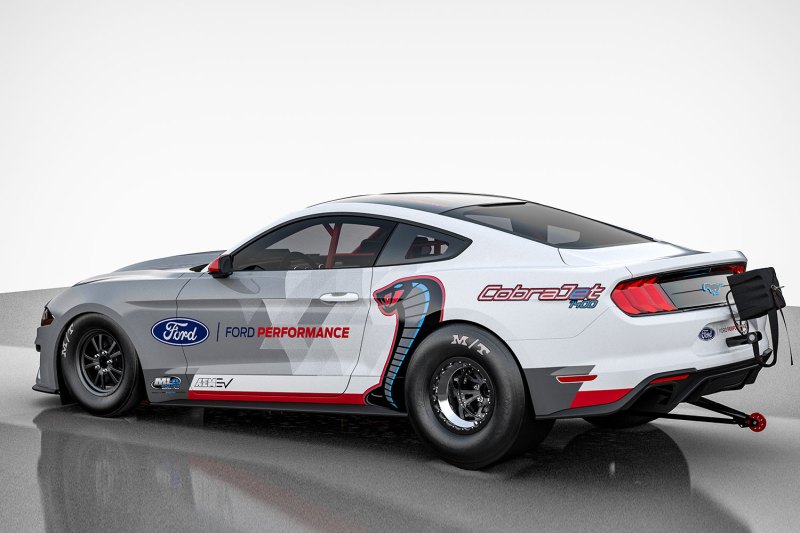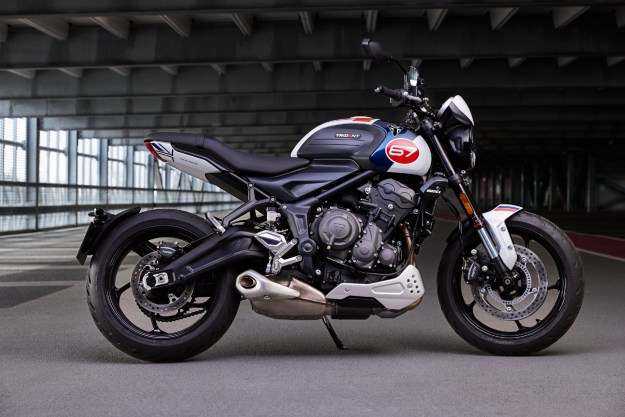Even if you’ve never been to a drag strip, you certainly know a few things about drag cars. One, they’re deafeningly loud. Two, they suck down a huge amount of fuel in a short period of time. Three, they’re blindingly fast. With the new Ford Mustang Cobra Jet 1400 prototype, Ford is looking to change the first two things, because it’s totally electric. So, it’ll still scream down the drag strip like a purpose-built dragster, but it’ll do so without using a drop of gasoline or bursting your eardrums.
This is exactly what we were thinking of when Ford said it was making an electric Mustang.

Before we get on with just how impressive the Mustang Cobra Jet 1400’s specs are, let’s take a little walk down memory lane to see how Ford ended up here. This is the first electric factory drag racer from the brand in 52 years, after all.
Mustang lovers already know about the Cobra Jet’s rich history. Initially introduced in the late ‘60s with 428-cubic-inch V8s, the Cobra Jet Mustang originally came to light because of Bob Tasca, the owner of Tasca Ford in Rhode Island. Tasca decided to build a Mustang that would dominate drag races and went to work using parts that Ford already offered. The machines were called the Tasca KR-8 and did the task of drag racing a little too well. Eric Dahlquist at Hot Rod magazine wrote an article on the Tasca KR-8 and asked readers to contact Ford if they wanted the brand to build a factory version of the car that they could buy. Ford apparently received so many letters that it decided to make one and called it the 428 Cobra Jet Mustang.

Since then, Ford introduced a Cobra Jet in 2008, from 2009 to 2016, and, more recently, in 2018. All of them have had V8 engines, except for the latest one. While some may be quick to call Ford’s latest act sacrilegious, especially after slapping the Mustang name onto the all-electric Mustang Mach-E SUV-like thing, this pony actually has the muscle to back up its rich nameplate.
Information is scarce for the Mustang Cobra Jet 1400, but the most important piece of news is that it makes 1,400 horsepower and 1,100-plus pound-feet of torque. Ford believes the battery-powered dragster can run the quarter-mile in the “low eight-second range at more than 170 mph.” That’s not as fast as the electricity powering the car, but it’s quicker and faster than the Cobra Jet that came out in 2018 which completed the run in the mid-eight-second range at 150 mph.
Ford claims the Mustang Cobra Jet 1400 is just a one-off at the moment, but is continuing to test the vehicle before its official debut, which will happen later this year. Probably when the automotive industry puts the coronavirus in the past. The automaker teamed up with multiple suppliers including MLe Racecars for the build, Watson Engineering for the roll cage, AEM EV to handle the software, and Casacdia for the inverter and motor.

With electric vehicles producing all of their torque immediately off the line, they make for excellent electric vehicles. With that kind of power straight from the get-go, though, the real limiting factor is the tires. Thankfully, sticky, massive drag tires are on hand to ensure grip is on hand when launching off the line, while a wheelie bar also helps drivers get a good start. Of course, there’s a parachute that drivers can deploy to bring the dragster to a stop at the end of the run.
This is the second electric Mustang that we’re excited about – the first being the Mustang Lithium concept we saw at last year’s SEMA. That pony car had 900 hp and a proper six-speed manual transmission. It was love at first sight — and it’s the same case with the Mustang Cobra Jet 1400.
As much as we love the electric dragster, Ford isn’t the first to play around with the possibility of an electric drag vehicle based on a muscle car. In 2018, Chevrolet came out with the Camaro eCOPO, an electric dragster based on the Camaro. Power for that battery-powered drag vehicle was rated at 700 hp and 600 lb-ft of torque, allowing the vehicle to complete the quarter-mile in roughly nine seconds.
Editors' Recommendations
- The 2025 Ford Mustang GTD is basically a street-legal race car
- Ford Shelby Mustang GT500KR Returns With Over 900 HP
- Ford Calling the Mustang Mach-E a Mustang Is Desperate
- Manned Flying Car Races Are Coming in 2022
- Chase Exotic Supercars on this Insane Police Car Drifting Ride-Along




